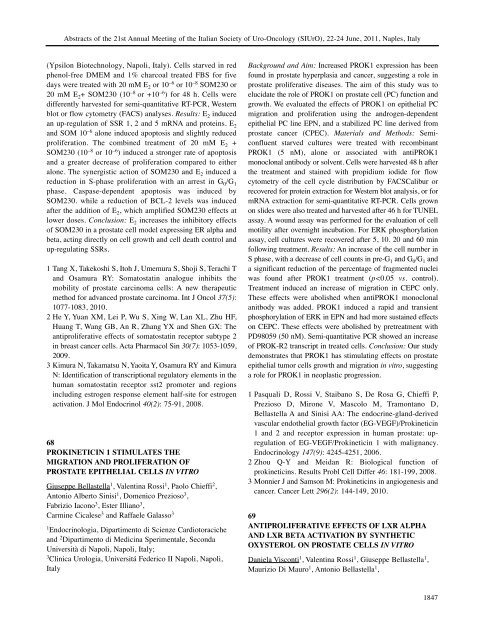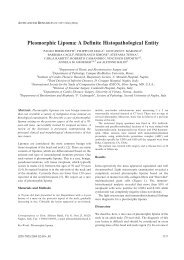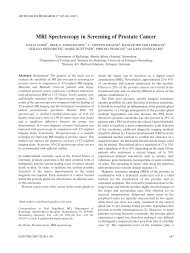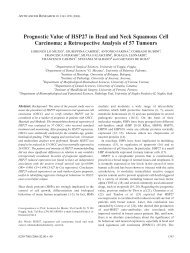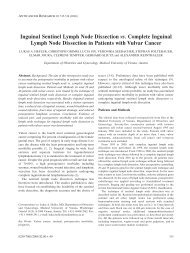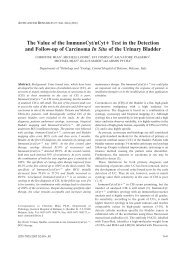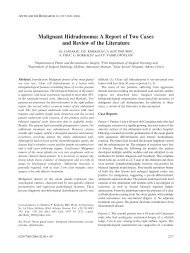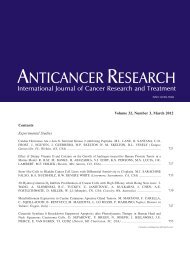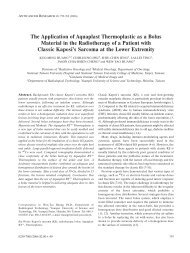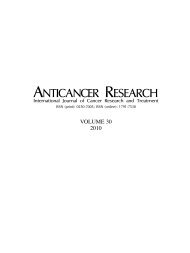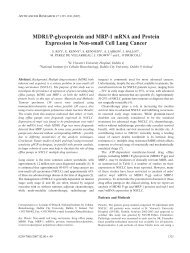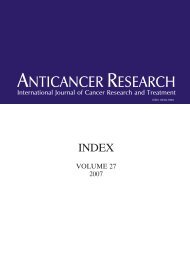ABSTRACTS OF THE 21st ANNUAL MEETING OF THE ITALIAN ...
ABSTRACTS OF THE 21st ANNUAL MEETING OF THE ITALIAN ...
ABSTRACTS OF THE 21st ANNUAL MEETING OF THE ITALIAN ...
You also want an ePaper? Increase the reach of your titles
YUMPU automatically turns print PDFs into web optimized ePapers that Google loves.
Abstracts of the <strong>21st</strong> Annual Meeting of the Italian Society of Uro-Oncology (SIUrO), 22-24 June, 2011, Naples, Italy<br />
(Ypsilon Biotechnology, Napoli, Italy). Cells starved in red<br />
phenol-free DMEM and 1% charcoal treated FBS for five<br />
days were treated with 20 mM E 2 or 10 –6 or 10 –8 SOM230 or<br />
20 mM E 2+ SOM230 (10 –8 or +10 –6 ) for 48 h. Cells were<br />
differently harvested for semi-quantitative RT-PCR, Western<br />
blot or flow cytometry (FACS) analyses. Results: E 2 induced<br />
an up-regulation of SSR 1, 2 and 5 mRNA and proteins. E 2<br />
and SOM 10 –6 alone induced apoptosis and slightly reduced<br />
proliferation. The combined treatment of 20 mM E 2 +<br />
SOM230 (10 –8 or 10 –6 ) induced a stronger rate of apoptosis<br />
and a greater decrease of proliferation compared to either<br />
alone. The synergistic action of SOM230 and E 2 induced a<br />
reduction in S-phase proliferation with an arrest in G 0/G 1<br />
phase. Caspase-dependent apoptosis was induced by<br />
SOM230. while a reduction of BCL-2 levels was induced<br />
after the addition of E 2, which amplified SOM230 effects at<br />
lower doses. Conclusion: E 2 increases the inhibitory effects<br />
of SOM230 in a prostate cell model expressing ER alpha and<br />
beta, acting directly on cell growth and cell death control and<br />
up-regulating SSRs.<br />
1 Tang X, Takekoshi S, Itoh J, Umemura S, Shoji S, Terachi T<br />
and Osamura RY: Somatostatin analogue inhibits the<br />
mobility of prostate carcinoma cells: A new therapeutic<br />
method for advanced prostate carcinoma. Int J Oncol 37(5):<br />
1077-1083, 2010.<br />
2 He Y, Yuan XM, Lei P, Wu S, Xing W, Lan XL, Zhu HF,<br />
Huang T, Wang GB, An R, Zhang YX and Shen GX: The<br />
antiproliferative effects of somatostatin receptor subtype 2<br />
in breast cancer cells. Acta Pharmacol Sin 30(7): 1053-1059,<br />
2009.<br />
3 Kimura N, Takamatsu N, Yaoita Y, Osamura RY and Kimura<br />
N: Identification of transcriptional regulatory elements in the<br />
human somatostatin receptor sst2 promoter and regions<br />
including estrogen response element half-site for estrogen<br />
activation. J Mol Endocrinol 40(2): 75-91, 2008.<br />
68<br />
PROKINETICIN 1 STIMULATES <strong>THE</strong><br />
MIGRATION AND PROLIFERATION <strong>OF</strong><br />
PROSTATE EPI<strong>THE</strong>LIAL CELLS IN VITRO<br />
Giuseppe Bellastella1 , Valentina Rossi1 , Paolo Chieffi2 ,<br />
Antonio Alberto Sinisi1 , Domenico Prezioso3 ,<br />
Fabrizio Iacono3 , Ester Illiano3 ,<br />
Carmine Cicalese3 and Raffaele Galasso3 1Endocrinologia, Dipartimento di Scienze Cardiotoraciche<br />
and 2Dipartimento di Medicina Sperimentale, Seconda<br />
Università di Napoli, Napoli, Italy;<br />
3Clinica Urologia, Universitá Federico II Napoli, Napoli,<br />
Italy<br />
Background and Aim: Increased PROK1 expression has been<br />
found in prostate hyperplasia and cancer, suggesting a role in<br />
prostate proliferative diseases. The aim of this study was to<br />
elucidate the role of PROK1 on prostate cell (PC) function and<br />
growth. We evaluated the effects of PROK1 on epithelial PC<br />
migration and proliferation using the androgen-dependent<br />
epithelial PC line EPN, and a stabilized PC line derived from<br />
prostate cancer (CPEC). Materials and Methods: Semiconfluent<br />
starved cultures were treated with recombinant<br />
PROK1 (5 nM), alone or associated with antiPROK1<br />
monoclonal antibody or solvent. Cells were harvested 48 h after<br />
the treatment and stained with propidium iodide for flow<br />
cytometry of the cell cycle distribution by FACSCalibur or<br />
recovered for protein extraction for Western blot analysis, or for<br />
mRNA extraction for semi-quantitative RT-PCR. Cells grown<br />
on slides were also treated and harvested after 46 h for TUNEL<br />
assay. A wound assay was performed for the evaluation of cell<br />
motility after overnight incubation. For ERK phosphorylation<br />
assay, cell cultures were recovered after 5, 10. 20 and 60 min<br />
following treatment. Results: An increase of the cell number in<br />
S phase, with a decrease of cell counts in pre-G 1 and G 0/G 1 and<br />
a significant reduction of the percentage of fragmented nuclei<br />
was found after PROK1 treatment (p


